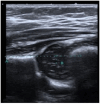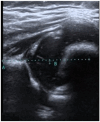Assessing Femoral Head Medialization in Developmental Hip Dysplasia Type 1 and Type 2 Hip Separation
- PMID: 39451640
- PMCID: PMC11506930
- DOI: 10.3390/diagnostics14202317
Assessing Femoral Head Medialization in Developmental Hip Dysplasia Type 1 and Type 2 Hip Separation
Abstract
Background/objectives: The prevalence of developmental hip dysplasia is estimated to be 0.1-2 per 1000 infants. Hip imaging by ultrasonography is considered to be the gold standard method for screening and detecting developmental dysplasia of the hip (DDH), as per the Graf categorization. The classification of hip differentiation into type 1 and type 2 is determined by the alpha angle, as assessed by the Graf classification. Type 1 hips are defined as those with an alpha angle exceeding 60 degrees, whilst type 2 hips are defined as those with measurements falling within the range of 50 to 59 degrees.
Methods: The computerized patient card in our institution had a compilation of 208 hip photographs taken from 110 patients, with 98 of them being bilateral. The acquisition of these photos occurred from January 2020 to December 2020. A retrospective review was conducted on the ultrasound (US) scans, with a specific emphasis on the outcomes related to type 1 and type 2 hips.
Results: There were 108 high-resolution US photos in the type 1 hip group and 100 high-resolution US images in the type 2 hip group. In terms of unilateral or bilateral cases, gender, or age, no statistically significant differences were seen between the two groups (p > 0.05). The FMD model exhibited a sensitivity of 86% and specificity of 70% in effectively predicting the presence of type 1 mature hips when the values surpassed 2.9 mm. The AUC (area under the curve) value achieved was 0.628.
Conclusions: The process of diagnostic categorization may occasionally encounter challenges in accurately differentiating between type 1 and type 2 hip separation subsequent to a hip ultrasound examination. The findings of our analysis indicate that the assessment of the FMD is a highly successful method, demonstrating both high specificity and sensitivity in differentiating between various scenarios.
Keywords: Graf classification; developmental dysplasia; femur; hip; measurement.
Conflict of interest statement
The authors declare no conflicts of interest.
Figures



Similar articles
-
Developmental retardation of femoral head size and femoral head ossification in mild and severe developmental dysplasia of the hip in infants: a preliminary cross-sectional study based on ultrasound images.Quant Imaging Med Surg. 2023 Jan 1;13(1):185-195. doi: 10.21037/qims-22-513. Epub 2022 Nov 15. Quant Imaging Med Surg. 2023. PMID: 36620134 Free PMC article.
-
Interobserver agreement and clinical disparity between the Graf method and femoral head coverage measurement in developmental dysplasia of the hip screening: A prospective observational study of 198 newborns.Medicine (Baltimore). 2021 Jun 18;100(24):e26291. doi: 10.1097/MD.0000000000026291. Medicine (Baltimore). 2021. PMID: 34128864 Free PMC article.
-
Does a Graf Type-I Hip Justify the Discontinuation of Pavlik Harness Treatment in Patients with Developmental Dislocation of the Hip?Children (Basel). 2022 May 20;9(5):752. doi: 10.3390/children9050752. Children (Basel). 2022. PMID: 35626929 Free PMC article.
-
Cochrane Review: Screening programmes for developmental dysplasia of the hip in newborn infants.Evid Based Child Health. 2013 Jan;8(1):11-54. doi: 10.1002/ebch.1891. Evid Based Child Health. 2013. PMID: 23878122 Review.
-
Ultrasonographic screening for developmental dysplasia of the hip: the Graf method revisited.Eur J Orthop Surg Traumatol. 2024 Feb;34(2):723-734. doi: 10.1007/s00590-023-03767-9. Epub 2023 Oct 26. Eur J Orthop Surg Traumatol. 2024. PMID: 37884843 Review.
References
-
- Kocher M.S. Ultrasonographic screening for developmental dysplasia of the hip: An epidemiologic analysis (part II) Am. J. Orthop. 2001;30:19–24. - PubMed
LinkOut - more resources
Full Text Sources
Research Materials

